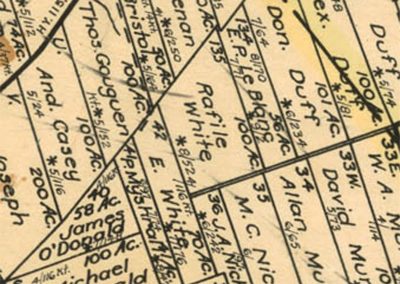Village des Fricots
This historical village was settled in the 1850s and had four houses. It was located inland in LeBlancville. An access road was built, off the main road (now Route 115) to reach the settlement. Today, when crossing the Kent-Westmorland county line heading southward to Moncton, the access road is to the left, about ½ km away. All houses were demolished.
1857
Raphaël LeBlanc first settled in Village des Fricots after being granted land on April 6, 1857. Soon afterwards, other pioneers arrived to settle: Maxime Cormier, Edouard LeBlanc, and Thomas LeBlanc, nicknamed “Thomas à fricot”. Thomas left the village in the early 1900s and moved to Western Canada.
1900
One-half ton of hay cost $3.50, one bushel grass seed $2.50, one pair of shoes $1.10, five locks and nobs $1.50, one bottle of Mother Seigel $0.30, one hundred lbs of flour $5, three lbs of tea $1.20, one gallon of oil $0.25, and one bottle of liniment $0.35 according to a record of household affairs.
1901
The Catholic church was officially named Notre-Dame-du-Sacré-Cœur and the parish officially defined the territory of the Notre-Dame community. The towns (or historic villages) included MacDougall Settlement, LeBlancville, Dufourville, Notre-Dame Centre, Guéguen, Hays, Alexandrina-Nor’ouest, the north and south sides of the river, Whites Settlement, in addition to the Village des Pishcots, Village des Fricots, Suretteville, Teed Road and the Chemin des Thaddées.
1932
A few people had electricity as early as 1932 and by 1940, service was widespread but did not reach every corner of the village. This proved to be a fatal blow to several settlements and the main reason why these areas were abandoned, such as Alexandrina-Nor’ouest, chemin des Thaddées, Village des Pishcots, Village des Fricots, and Suretteville.


